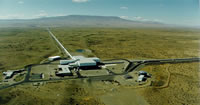Listening for Gravitational Waves
By: Peter Shawhan

Gravity is part of our everyday lives, in obvious ways and in some ways which are not so obvious. Gravity holds the Earth together and keeps our feet, the oceans and the atmosphere on its surface. It holds the gas of the Sun together in a relatively dense ball, allowing hydrogen atoms to collide and fuse into helium, producing heat and light. Of course, it also keeps the Earth and other planets in orbit around the Sun. In daily human activities, the force of gravity seems to be constant, but that is not quite true. The net gravitational pull at a given point on the Earth varies during the day as the distances to the Sun, Moon, and other planets change; although the variations are small, they are enough to create tides on the oceans. Since all objects exert a gravitational force according to their mass, even a truck driving by on the street outside exerts a gravitational force while it is nearby, but (fortunately) it is much too weak to be noticed.
Albert Einstein, with his general theory of relativity, forged a radical new way of thinking about gravity, in terms of "curvature" in the geometry of space-time rather than as an ad hoc, instantaneous force. Among other things, the theory predicts that a gravitational potential can bend the path of a beam of light and can change the wavelength of the light, both of which were experimentally confirmed in the last century. Another prediction is that changes in a gravitational potential propagate at the speed of light as gravitational waves, momentary distortions of the geometry of space-time that travel outward from the source. Only very massive objects, changing their shape or orientation at speeds close to the speed of light, can produce gravitational waves with significant amplitude; but then the amplitude falls off only as 1/r (where r is the distance from the source to the detector), unlike the 1/r2 dependence of the gravitational force. Certain types of astrophysical events, such as supernova explosions or merging black holes or neutron stars, should emit gravitational waves that could be detected at a considerable distance, and the waves would carry unique information about such events. Ultimately, regular gravitational wave observations could join electromagnetic (optical, microwave, radio, X-ray, gamma-ray) and particle (cosmic ray, neutrino) astronomy as different ways to look at the universe.
There is excellent indirect evidence for gravitational waves from observations of orbital changes in binary pulsar systems, but direct detection has been elusive because the wave amplitudes are incredibly small. A "typical" gravitational wave might produce a fractional distortion (i.e., a strain) of only 10-21 at the Earth, which would momentarily stretch the diameter of the Earth by about the size of an atomic nucleus! Joseph Weber, here at the University of Maryland, was the first person to try to build instruments capable of detecting such tiny signals, using suspended metal cylinders instrumented with sensitive transducers to pick up vibrations induced by a gravitational wave. Weber's basic design has been improved over the years, with major contributions made by scientists here at Maryland, and a few such detectors are still operating.  However, physicists are now focusing on a However, physicists are now focusing on a
xnewer type of detector: a large L-shaped laser interferometer which measures the difference
xbetween the effective lengths of the two "arms" of the L. The Laser Interferometer
xGravitational-wave Observatory (LIGO) project, funded by the National Science Foundation, xis leading the way in this effort. LIGO's two observatories--in Washington State and
xLouisiana--house a total of three such detectors, with arm lengths up to 4 kilometers long.
xBesides being impressive facilities when viewed from the air, they contain cutting-edge materials and engineering: 11-kilogram cylindrical mirrors with extremely high-quality coatings bounce laser beams back and forth along the arms inside a vacuum enclosure, with all components isolated from ground vibrations and other environmental disturbances as much as possible, and held in place with sub-nanometer precision. The arms form a sort of antenna which responds to signals coming from most of the sky, even upward through the Earth; therefore, instead of "looking" at a spot in the sky like an optical telescope or a radio telescope, LIGO "listens" for gravitational waves arriving from all around.
After many years of construction and commissioning, LIGO has now reached the sensitivity it was designed for and is currently in the middle of a long data collection run. The data is now being searched for many different sources, although we have limited knowledge of what is out there--which is why this new exploration of the gravitational-wave sky is so exciting! For instance, we should now be able to detect merging black holes as far away as a few hundred million light-years, but we don't know how common black holes mergers are in the universe. LIGO is joined in this effort by the smaller GEO 600 detector in Germany, and in the near future will also exchange data with the 3-kilometer VIRGO detector in Italy in a cooperative arrangement to analyze the data jointly for maximum sensitivity to weak signals.
As a long-time member of the LIGO Scientific Collaboration (LSC), I have helped to commission the detectors and to develop data analysis methods and tools, and have led some of the search projects. The primary part of my current research plan is to search the data for short "burst" signals of all types; it is challenging to separate a signal from detector noise when the form of the signal is not known, but we are refining methods for doing so. We cannot predict when the first gravitational-wave signal will be detected, but with patience and care we can be ready for it when it arrives.
Dr. Shawhan is an assistant professor of Physics for the University of Maryland . He is a member of the Gravity Experiment research group. Feel free to contact him at, pshawhan@umd.edu .
|